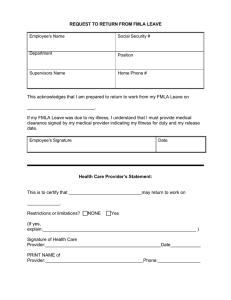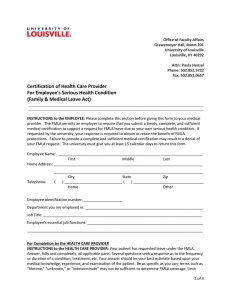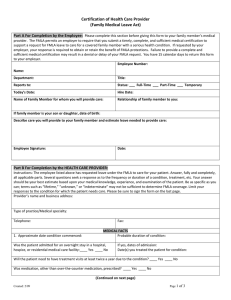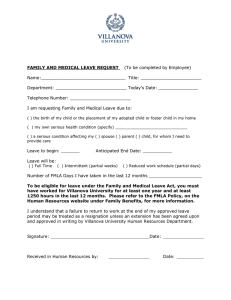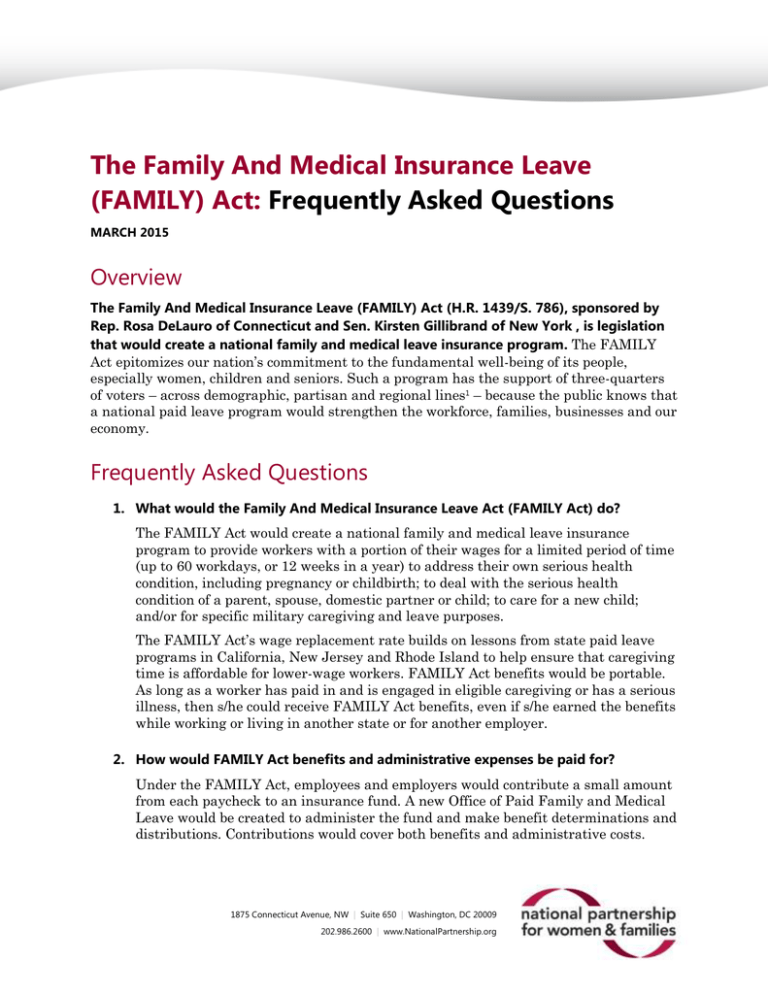
The Family And Medical Insurance Leave
(FAMILY) Act: Frequently Asked Questions
MARCH 2015
Overview
The Family And Medical Insurance Leave (FAMILY) Act (H.R. 1439/S. 786), sponsored by
Rep. Rosa DeLauro of Connecticut and Sen. Kirsten Gillibrand of New York , is legislation
that would create a national family and medical leave insurance program. The FAMILY
Act epitomizes our nation’s commitment to the fundamental well-being of its people,
especially women, children and seniors. Such a program has the support of three-quarters
of voters – across demographic, partisan and regional lines1 – because the public knows that
a national paid leave program would strengthen the workforce, families, businesses and our
economy.
Frequently Asked Questions
1. What would the Family And Medical Insurance Leave Act (FAMILY Act) do?
The FAMILY Act would create a national family and medical leave insurance
program to provide workers with a portion of their wages for a limited period of time
(up to 60 workdays, or 12 weeks in a year) to address their own serious health
condition, including pregnancy or childbirth; to deal with the serious health
condition of a parent, spouse, domestic partner or child; to care for a new child;
and/or for specific military caregiving and leave purposes.
The FAMILY Act’s wage replacement rate builds on lessons from state paid leave
programs in California, New Jersey and Rhode Island to help ensure that caregiving
time is affordable for lower-wage workers. FAMILY Act benefits would be portable.
As long as a worker has paid in and is engaged in eligible caregiving or has a serious
illness, then s/he could receive FAMILY Act benefits, even if s/he earned the benefits
while working or living in another state or for another employer.
2. How would FAMILY Act benefits and administrative expenses be paid for?
Under the FAMILY Act, employees and employers would contribute a small amount
from each paycheck to an insurance fund. A new Office of Paid Family and Medical
Leave would be created to administer the fund and make benefit determinations and
distributions. Contributions would cover both benefits and administrative costs.
1875 Connecticut Avenue, NW | Suite 650 | Washington, DC 20009
202.986.2600 | www.NationalPartnership.org
3. What is a “serious health condition” under the FAMILY Act?
A serious health condition would be defined as it is by the U.S. Department of Labor
for the purpose of taking leave under the Family and Medical Leave Act (FMLA) –
an illness, injury, impairment, or physical or mental condition that involves:
any period of incapacity or treatment connected with inpatient care (i.e., an
overnight stay) in a hospital, hospice or residential medical care facility; or
a period of incapacity requiring absence of more than three calendar days
from work, school or other daily activities that also involves continuing
treatment by (or under the supervision of) a health care provider; or
any period of incapacity due to pregnancy or for prenatal care; or
any period of incapacity (or treatment therefore) due to a chronic serious
health condition (e.g., asthma, diabetes, epilepsy, etc.); or
a period of incapacity that is permanent or long-term due to a condition for
which treatment may not be effective (e.g., Alzheimer's, stroke, terminal
diseases, etc.); or
any absences to receive multiple treatments (including any period of recovery
therefrom) by, or on referral by, a health care provider for a condition that
likely would result in incapacity of more than three consecutive days if left
untreated (e.g., chemotherapy, physical therapy, dialysis, etc.).
4. How much paid time off would the FAMILY Act guarantee?
The FAMILY Act would allow eligible employees to receive insurance benefits for up
to 60 workdays or “caregiving days” (the equivalent of 12 weeks) within a one-year
period.
5. Could FAMILY Act leave be taken intermittently or would it all have to be taken at
once?
There is nothing in the bill that requires that all 12 weeks be taken all at once.
6. How much money would individuals receive during time away from their jobs?
Benefits would amount to 66 percent of an individual’s monthly wages (based on
highest annual earnings from the prior three years), up to a capped monthly amount,
and would be indexed to the national average wage index. If a person takes the
maximum number of days, the benefits would range from a minimum benefit of $580
to a maximum benefit of $4,000 per month in the program’s first year.
Example: If a person whose highest annual income in the last three years is
$34,400 takes five caregiving days in a month, his/her monthly benefit would
be $477. If s/he took all 20 days, the benefit would be $1,911 per month.
7. Do any states already have paid family and medical leave laws?
Yes, the FAMILY Act builds on state family and medical leave insurance programs
that have a strong record of success. Personal medical leave through state
NATIONAL PARTNERSHIP FOR WOMEN & FAMILIES | FREQUENTLY ASKED QUESTIONS | THE FAMILY ACT
2
temporary disability insurance programs has been working well for decades in
California, Hawaii, New Jersey, New York, Rhode Island and Puerto Rico. Family
leave insurance programs have existed in California since 2004 and New Jersey
since 2009. Rhode Island passed a family leave insurance program in 2013 that was
implemented in January 2014.
Analyses of California’s law show that both employers and employees benefit from
the program.2 In New Jersey, program costs are even lower than expected and public
attitudes toward the program are favorable.3 A preliminary analysis of Rhode
Island’s first year also shows favorable results.4 More state progress is on the
horizon, but a national standard is both necessary and more efficient.
8. Who would be eligible for FAMILY Act benefits?
Private sector workers and self-employed people who have a basic level of work and
earnings history would be eligible to apply for benefits under the FAMILY Act.
Public employees who pay into and are eligible for Social Security benefits would
also pay into and be eligible for FAMILY Act benefits. For all workers, eligibility for
FAMILY Act benefits would be based on the work history or “work credit”
requirements of Social Security Disability Insurance. Details can be found here.5
Eligibility rules would allow younger, part-time and lower-wage workers to
contribute to the family and medical leave insurance fund and to receive insurance
benefits from it, regardless of their employer’s size or their length of time on the job.
9. What if an individual works for a business with fewer than 50 employees?
FAMILY Act benefits would be available to every individual who has the earnings
and work history necessary to qualify for Social Security Disability Insurance;
eligibility is not tied to FMLA eligibility. This will allow young, part-time and lowerwage workers to access FAMILY Act benefits even if their employer’s size or their
attachment to their current employer makes them ineligible for the job protection
offered through the FMLA.
10. How much would the FAMILY Act cost a typical worker?
For an employee who is paid the nation’s median wage or salary income of $32,196
per year, the benefit would cost about $1.24 per week, or less than $65 per year.
Full-time, year-round workers who are paid a higher median annual wage or salary
income of $43,579 per year would pay $1.68 per week, or less than $88 per year.6
11. Can a worker or employer opt out of contributing to the fund?
No. The FAMILY Act is designed to be a national program that is supported by
every worker and every employer. Allowing people or employers to opt-out would
change the cost structure of the program and make it much more expensive for those
who participate. The FAMILY Act does recognize that some employers provide
benefits on their own and that some states have their own paid leave insurance
programs in place. It would work in tandem with those benefits, offering advantages
to employees and employers, but still require contributions to the federal program.
NATIONAL PARTNERSHIP FOR WOMEN & FAMILIES | FREQUENTLY ASKED QUESTIONS | THE FAMILY ACT
3
12. How much would the FAMILY Act cost the government to create and maintain?
The FAMILY Act insurance program would be self-funded through employee and
employer payroll contributions. A one-time appropriation from general revenues
would be necessary to cover initial benefits and administrative costs. Under the law,
this would have to be paid back in 10 years.
13. Would individuals have to tell their employers why they are taking leave?
Yes, the FAMILY Act requires an application for benefits that includes a statement
that a worker has notified his or her employer of intent to take leave, similar to the
current certification requirements for leave under the FMLA. The same medical
privacy protections in place under the FMLA would apply in the FAMILY Act
context too.
14. Could an individual be fired for requesting FAMILY Act leave?
No, the FAMILY Act would make it illegal to fire or discriminate against an
individual who has applied, intends to apply for or who uses family and medical
leave insurance benefits. This means that employers would not be able to take an
adverse employment action against an employee simply because the employee
applied for or drew on FAMILY Act benefits. However, employers that are exempt
from the FMLA (those with fewer than 50 employees) would not be required to hold
employees’ jobs or reinstate employees, as long as their reasons for doing so were not
discriminatory.
15. How does the FAMILY Act relate to the Family and Medical Leave Act (FMLA)?
The insurance program created through the FAMILY Act would run parallel to but
separate from the FMLA. An important similarity is that the reasons for which a
person can take leave under the FAMILY Act and the FMLA are the same. In other
words, the reasons that qualify a worker for FMLA leave are the same reasons that
qualify a worker for FAMILY Act insurance benefits. Individuals who qualify for
FMLA leave would also be able to apply for FAMILY Act benefits.
What makes the FAMILY Act and the FMLA significantly different is that the
FAMILY Act provides partial wage replacement during a period of leave to eligible
workers regardless of their current employer’s size or their time at that job.
Providing pay during a family or medical leave addresses the single most common
reason workers give for not taking FMLA leave when they need it: the financial
impossibility of taking unpaid leave.7
16. Are there measures to prevent fraud and abuse?
Yes, the fraud and abuse prevention measures included in the FAMILY Act are
similar to those for Social Security. If a person is caught lying to receive benefits, they
will be banned from the program for one year. But, based on data from California,
fraud and abuse are not expected to be a common problem. Very few California
employers suspected abuse, and even fewer were able to confirm a case of abuse.8
NATIONAL PARTNERSHIP FOR WOMEN & FAMILIES | FREQUENTLY ASKED QUESTIONS | THE FAMILY ACT
4
17. What would happen to existing state family leave or state temporary disability
insurance programs if the FAMILY Act were enacted?
The FAMILY Act would not preempt or supersede state laws that provide paid
family and medical leave insurance benefits, so there is nothing in the bill to
discourage continued state progress. Under the FAMILY Act, workers in states with
existing temporary disability insurance or family leave insurance programs could
choose to receive benefits simultaneously (with federal benefits offset by state
benefits) or sequentially (with full federal and state benefits paid out). When state
laws allow workers to take leave to care for family members not covered by federal
law (e.g., siblings, grandparents, grandchildren and parents-in-law), the more
generous state rights would be available to the worker just as they are now.
18. Which government agency would administer the FAMILY Act?
A new Office of Paid Family and Medical Leave would be established within the
Social Security Administration (SSA) to administer the program. The new office
would be responsible for determining eligibility, making payments, maintaining
records, preventing fraud and abuse, providing employers with notices about the
availability of benefits to share with employees, data collection, education and
outreach. The new office would build on SSA’s expertise in administering benefits,
but the new infrastructure and administrative costs would be paid for by the new
insurance fund and would not drain existing SSA resources.
19. How would the FAMILY Act impact Social Security?
The FAMILY Act would not negatively impact Social Security because the FAMILY
Act’s family and medical leave insurance fund would be entirely separate and selffunded. The new fund would be completely separate from the Social Security Trust
Fund, and the new payroll tax would generate the funding to administer the
program and cover benefits. In fact, over time, the FAMILY Act would have a
positive impact on Social Security because paid leave improves workforce
attachment, which means more workers paying taxes and contributing to the Social
Security system.
1 Lake Research Partners & Chesapeake Beach Consulting survey of 1,024 registered voters, January 23-28, 2013.
2 Bartel et al. (2014, June). California’s Paid Family Leave Law: Lessons from the First Decade. U.S. Department of Labor Publication. Retrieved 6 March 2015, from
http://www.dol.gov/asp/evaluation/reports/PaidLeaveDeliverable.pdf
3 Press of Atlantic City. (2010, November 15). Paid Family Leave / Working well. Retrieved 6 March 2015, from
http://www.pressofatlanticcity.com/opinion/editorials/article_0d6ba980-3a1d-56f7-9101-258999b5d9d0.html; See also Houser, L., & White, K. (2012). Awareness of New Jersey’s
Family Leave Insurance Program is Low, Even as Public Support Remains High and Need Persists. Rutgers University, The State University of New Jersey Center for Women and
Work Publication. Retrieved 3 March 2015, from http://njtimetocare.com/sites/default/files/03_New%20Jersey%20Family%20Leave%20Insurance%20A%20CWW%20Issue%20Brief.pdf
4 National Partnership for Women & Families. (2015, February). First Impressions: Comparing State Paid Family Leave Programs in Their First Years. Retrieved 5 March 2015, from
http://www.nationalpartnership.org/research-library/work-family/paid-leave/first-impressions-comparing-state-paid-family-leave-programs-in-their-first-years.pdf
5 Social Security Administration. (n.d.). Disability Planner: How Much Work Do You Need? Retrieved 6 March2015, from http://www.ssa.gov/dibplan/dqualify2.htm
6 National Partnership for Women & Families calculations based on median wage and salary for all workers and for full-time, full-year workers. Data source: U.S. Census Bureau.
(2013, 17 September). 2012 Person Income Tables of Contents. Retrieved 5 March 2015, from http://www.census.gov/hhes/www/cpstables/032013/perinc/pinc10_000.htm
7 Abt Associates. (2012, September). Family and Medical Leave in 2012: Technical Report. Retrieved 3 March 2015, from http://www.dol.gov/asp/evaluation/fmla/fmla2012.htm
8 Appelbaum, E., & Milkman, R. (2011). Leaves That Pay: Employer and Worker Experiences with Paid Family Leave in California. Center for Economic and Policy Research
Publication. Retrieved 5 March 2015, from http://www.cepr.net/index.php/publications/reports/leaves-that-pay
© 2015 National Partnership for Women & Families. All rights reserved.
NATIONAL PARTNERSHIP FOR WOMEN & FAMILIES | FREQUENTLY ASKED QUESTIONS | THE FAMILY ACT
5

